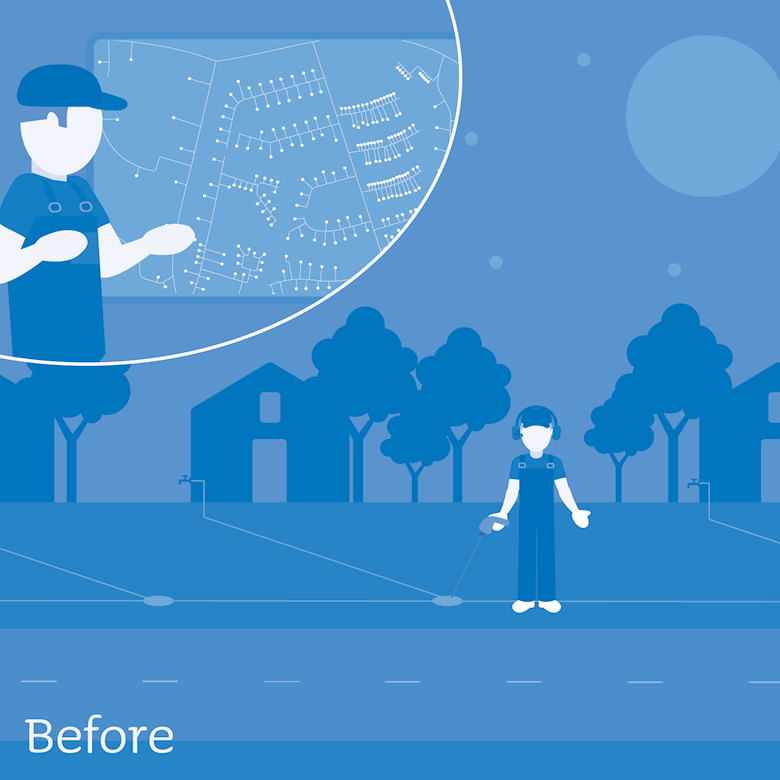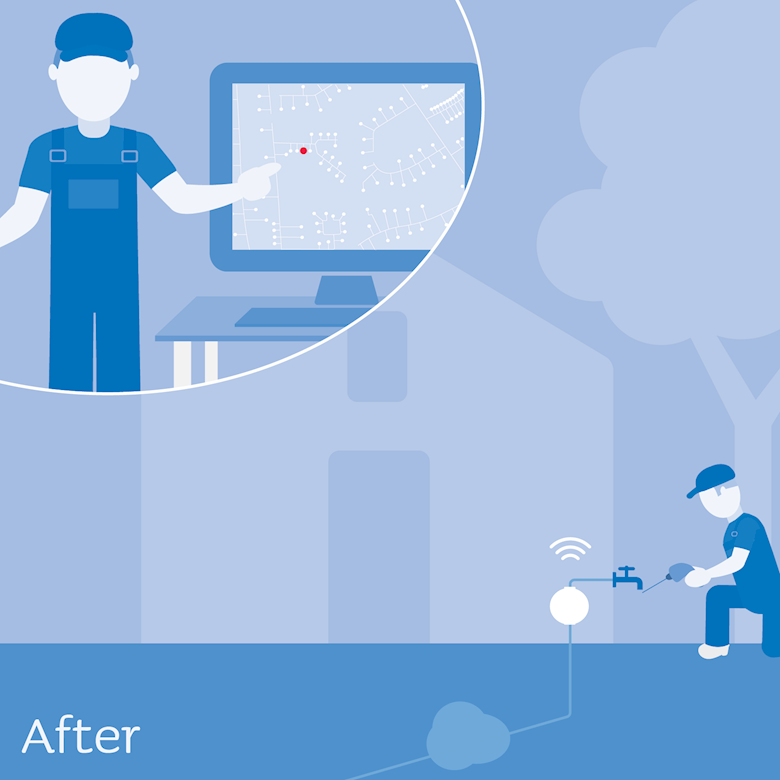Posted on Wednesday, April 15, 2020 by Martin Møller Værum
It is time to rethink leak detection
The traditional way of locating leaks isn’t really that effective anymore. If you search for leaks by listening to stop valves, chances are that there are leaks in your systems that you can’t hear or find without changing your approach.
All around us, technologies are rapidly changing. And as the tools and technology we use in our daily work develop, so must our ways of doing these daily tasks. Changing habits and learning a new workflow can be exhausting, but it can also relieve stress and manual labour, as we become more effective. In this post, I want to draw up how the traditional approach to leak detection is being challenged due to new developments – specifically the recent launch of our smart metering solution that also offers acoustic leak detection.
What we do today
The most common way of doing active leakage detection today is to manually search through a section or district from one end to another. This method is often coupled with listening equipment such as correlators and listening sticks that can be used on the ground and on the stop valves. It requires a lot of time and needs to be done in periods where it is completely quiet (mostly during the night), as flow in the pipes, traffic and even rain can interfere with the listening equipment.
This process is well known and used by a lot of water utilities but the problem is that it is a one-time fix that is done maybe 1 or 2 times per year per district. If a new leak occurs after the leak detection has been done, then the leak will not be found until the next leak detection initiative is planned, unless the leak is big enough to reach the surface.
And why is that no longer as sufficient?
It all started with an idea – could our smart water meters also be used to register the sound created by leaks? Spoiler: It could.
It all started with an idea – could our smart water meters also be used to register the sound created by leaks? Spoiler: It could.
With our new solution, it is now possible to use smart meters to monitor for leaks directly in the pipes. This is a huge step forward in the leakage detection area as it gives us continuous insights into what is happening in the pipes throughout the entire supply area – without having to go out into the field.
And one of the things that we have discovered is that many leaks actually can’t be found by just listening to the stop valves. In the field test of our new solution, we located several installations where we could register an elevated noise level, but listening at the stop valves were not enough to verify the leaks. We simply could not “hear” them even though they were obviously there.
This is interesting as it is an indication that the traditional way of locating leaks isn’t really that effective after all. And why is the stop valves not the optimal place to listen when you try to locate a leak? The listening equipment has to pass through both the valve and all the way down to the pipe in the ground. This means that there is a lot of noise barriers along the way that can reduce your chance of being able to “hear” a possible leak.
So, if you search for leaks by listening to stop valves, chances are that there are leaks in your systems that you can’t hear without changing your approach.
A new way of identifying leaks
Imagine that all the residential meters in your supply area are equipped with acoustic leak detection and that you have a system to visualise and filter the noise data so that it is easy to identify high risk installations.
Once you have a list of the most “interesting” installations in terms of the noise level, you still need to go out to verify if there is an actual leak. But as we have seen above, it is important not just to listen to the stop valves.
Rather, we have found that it is necessary to listen to the pipes closer to the house, like just by the smart meter or perhaps on an outdoor tap, to be able to properly hear the tell-tale noise of a leak. When verifying a leak, it is often also beneficial to be two people. One to open and close the stop valve, and one closer to the meter who can listen for changes in the sound patterns as the valve is being opened and closed.
Rather, we have found that it is necessary to listen to the pipes closer to the house, like just by the smart meter or perhaps on an outdoor tap, to be able to properly hear the tell-tale noise of a leak. When verifying a leak, it is often also beneficial to be two people. One to open and close the stop valve, and one closer to the meter who can listen for changes in the sound patterns as the valve is being opened and closed.
Another way of verifying a potential leak is simply to remove the existing meter and put in a temporary pressure sensor to monitor the pressure in high resolution as the valve is opened and closed. If the pressure drops when the valve is closed then this will most likely mean that a leak is present on the service connection.
Ageing infrastructure and water loss are among the primary challenges that we, as an industry, need to tackle to effectively deliver on SDG nr. 6. And to do so, we need to “disrupt” our traditional ways of working to become more proactive, targeted and efficient. And while the economic aspect of NRW is undoubtedly very important, we must not forget that there are more consequences from leakages than just lost revenue. We also need to consider the fact that our high quality drinking water should be supplied to the consumers without the risk of contamination. And any leaks on the pipe represents a potential risk of polluting the en-tire system with bacteria’s and dirt.
Our new solution for smart metering and acoustic leak detection is just one attempt of doing just that for how we detect leakages. I look forward to seeing what we can achieve together as the next step.
Write a comment below or check this out if you want to learn more about our new solution for smart metering and acoustic leak detection.



